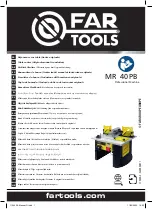
26
AT-AR256E v3 - 4 Ports ADSL2/2+ Router - User Manual
Category
Field
Description
Domain
The domain name is used in conjunction with the host name to uniquely identify
the router. To access the web pages of the router you can type 192.168.1.1
(the IP address) or AlliedTelesis.ATI (Host Name.Domain).
Enables/disables DHCP. By default, your router has the DHCP server (LAN
side) enabled. If you already have a DHCP server running on your network, you
must disable one of the two DHCP servers.
Assign
ISP DNS,
SNTP
Enable/disables the Assign ISP DNS, SNTP feature when the DHCP server of
your router has been enabled. To learn more, please refer to
Assign ISP DNS,
SNTP
.
Start IP
The Start IP Address is where the DHCP server starts issuing IP addresses.
This value must be greater than the IP address value of the router. For example,
if the IP address of the router is 192.168.1.1 (default) then the starting IP
address must be 192.168.1.2 (or higher).
If you change the start and/or end values, make sure the values are still
within the same subnet as the router. In other words, if the IP address of the
router is 192.168.1.1 (default) and you change the DHCP start/end IP
addresses to be 192.168.1.2/192.168.1.100, you cannot communicate
with the router if your host has DHCP enabled.
End IP
The End IP Address is where the DHCP server stops issuing IP addresses. The
ending address cannot exceed a subnet limit of 254; hence, the max value for
the default gateway is 192.168.1.254. If the DHCP server runs out of DHCP
addresses, users do not get access to network resources. If this happens, you
can increase the Ending IP address (to the limit of 254) or reduce the lease time.
If you change the start and/or end values, make sure the values are still
within the same subnet as the IP address of the router. In other words, if the
IP address of the router is 192.168.1.1 (default) and you change the DHCP
start/end IP addresses to be 192.168.1.2/192.168.1.100, you cannot
communicate with the router if your host has DHCP enabled.
Enable
DHCP
Server
Lease
Time
The Lease Time is the amount of time that a network user is allowed to
maintain a network connection to the router using the current dynamic IP
address. At the end of the Lease Time, the lease is either renewed or the
DHCP server issues a new IP. The amount of time is in units of seconds. The
default value is 3600 seconds (1 hour). The maximum value is 999999 seconds
(About 278 hours).
In addition to the DHCP server feature, the router supports the DHCP relay
function. When the router is configured as DHCP server, it assigns the IP
addresses to the LAN clients. When the gateway is configured as DHCP relay,
it is responsible for forwarding the requests and responses negotiated between
the DHCP clients and the server.
Enable
DHCP Relay
Relay IP
The IP address of the DHCP relay server.
Server and
Relay Off
When the DHCP server and relay functions are turned off, the network
administrator must carefully configure the IP address, Subnet Mask, and DNS
settings of every host on your network. Do not assign the same IP address to
more than one host. Also, your router must reside on the same subnet as all
the other hosts.
Assign ISP DNS, SNTP
When you enable the DHCP server, the router dynamically assigns IP addresses to computers in the local
network. The router provides its own LAN IP address (192.168.1.1) as both the gateway and the DNS
server.
The router has a choice of advertising its own IP address (192.168.1.1) as the DNS server or providing the
DNS that was received from the WAN. This can be configured by enabling/disabling
Assign ISP DNS
SNTP
on the
LAN Group Configuration
page.
ISP DNS, SNTP only applies when the DHCP server is enabled on the LAN Group Configuration page
















































